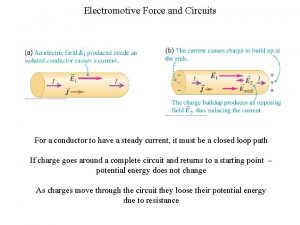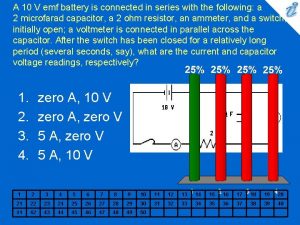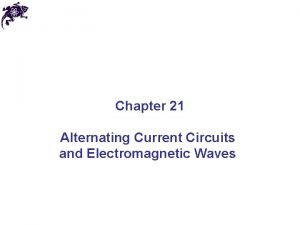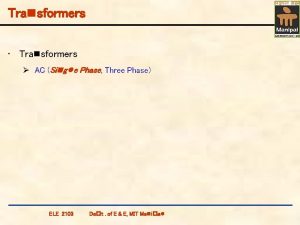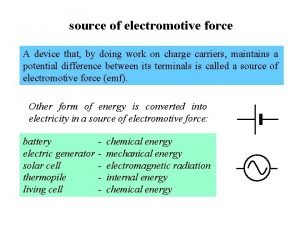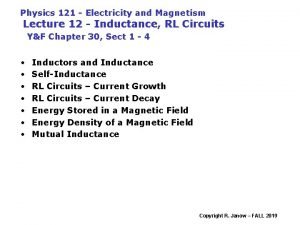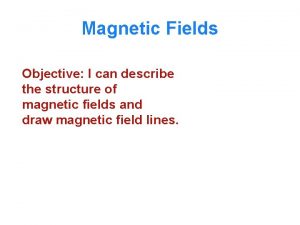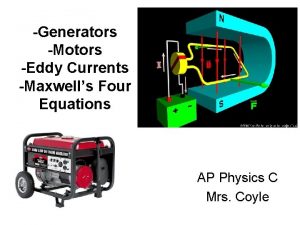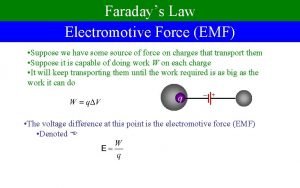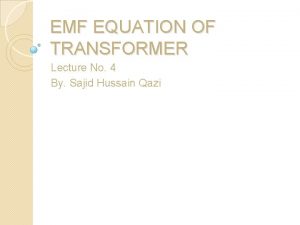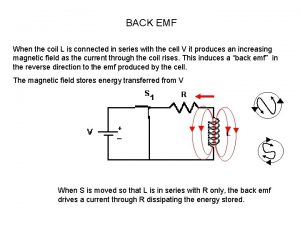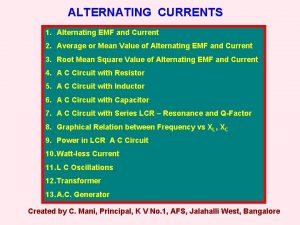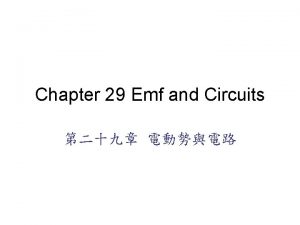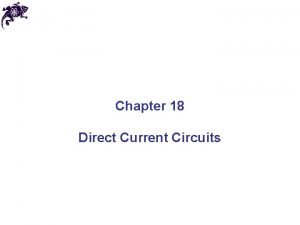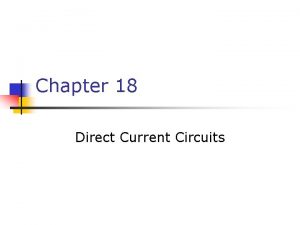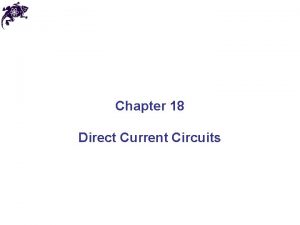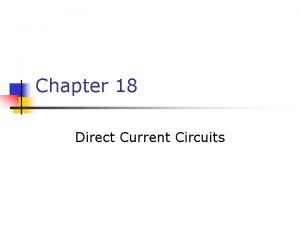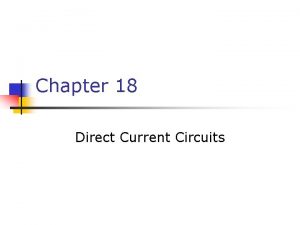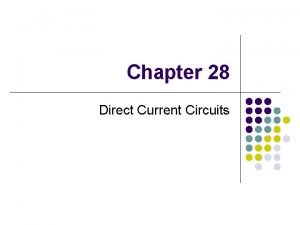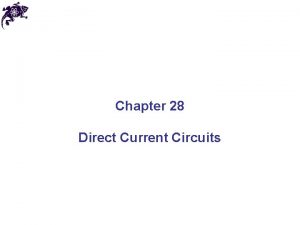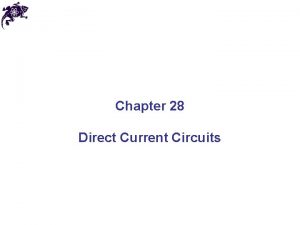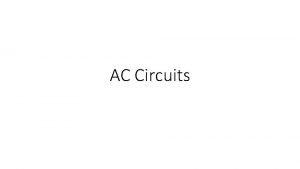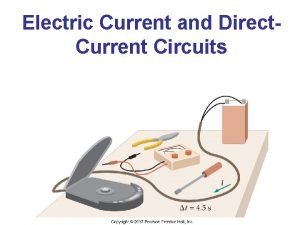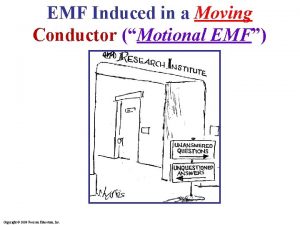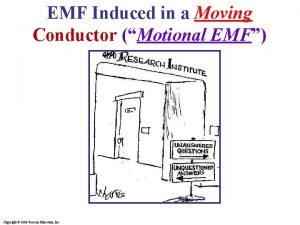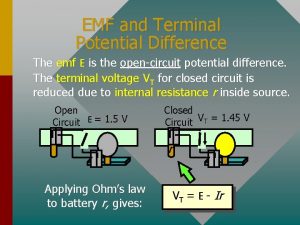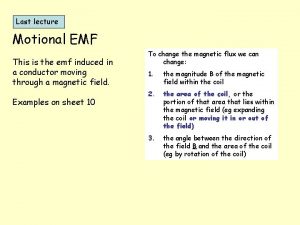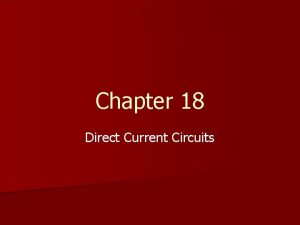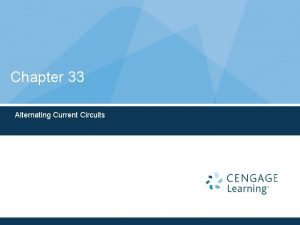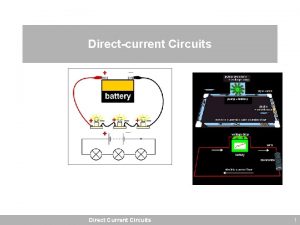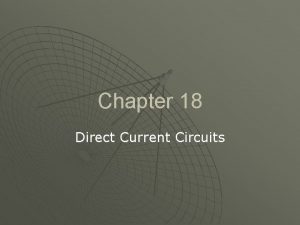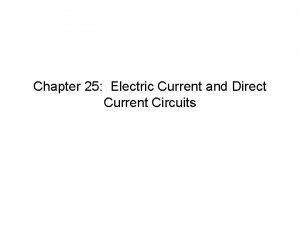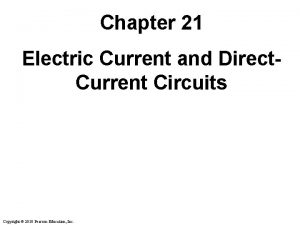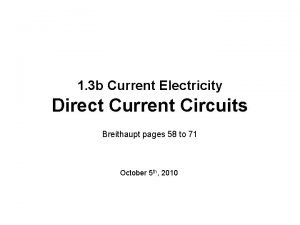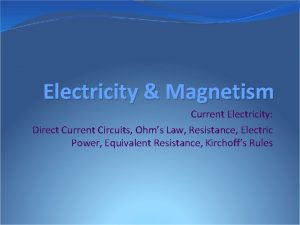Chapter 3 Direct Current Circuits 3 1 EMF


























- Slides: 26


Chapter 3 Direct Current Circuits: 3 -1 EMF 3 -2 Resistance in series and parallel. 3 -3 Rc circuit 3 -4 Electrical instruments 1 -11 -2017 FCI 2

Example: (A) Find the current in the circuit. starting at a, we see that a b represents a potential difference of + Ɛ 1 b c represents a potential difference of -IR 1, c d represents a potential difference of - Ɛ 2, and d a represents a potential difference of -IR 2 1 -11 -2017 FCI 3

The negative sign for I indicates that the direction of the current is opposite the assumed direction. (B) What power is delivered to each resistor? What power is delivered by the 12 -V battery? 1 -11 -2017 FCI 4

Problem-Solving Strategy – Kirchhoff’s Rules Draw the circuit diagram and assign labels and symbols to all known and unknown quantities Assign directions to the currents. Apply the junction rule to any junction in the circuit Apply the loop rule to as many loops as are needed to solve for the unknowns Solve the equations simultaneously for the unknown quantities Check your answers 1 -11 -2017 FCI 5

Example: A) Under steady-state conditions, find the unknown currents I 1, I 2, and I 3 in the multiloop circuit shown in Figurev 1 -11 -2017 FCI 6

(B) What is the charge on the capacitor? We can apply Kirchhoff’s loop rule to loop bghab (or any other loop that contains the capacitor) to find the potential difference ∆Vcap across the capacitor. We use this potential difference in the loop equation without reference to a sign convention because the charge on the capacitor depends only on the magnitude of the potential difference. Moving clockwise around this loop, we obtain 1 -11 -2017 FCI 7

Quiz 3: In using Kirchhoff’s rules, you generally assign a separate unknown current to (a) each resistor in the circuit (b) each loop in the circuit (c) each branch in the circuit (d) each battery in the circuit. 1 -11 -2017 FCI 8

Ans. (c) each branch in the circuit A current is assigned to a given branch of a circuit. There may be multiple resistors and batteries in a given branch. 1 -11 -2017 FCI 9

RC Circuits A direct current circuit may contain capacitors and resistors, the current will vary with time When the circuit is completed, the capacitor starts to charge The capacitor continues to charge until it reaches its maximum charge (Q = Cε) Once the capacitor is fully charged, the current in the circuit is zero 1 -11 -2017 FCI 10

Charging Capacitor in an RC Circuit The charge on the capacitor varies with time q = Q(1 – e-t/RC) The time constant, =RC The time constant represents the time required for the charge to increase from zero to 63. 2% of its maximum 1 -11 -2017 FCI 11

The following dimensional analysis shows that τ has the units of time: The energy output of the battery as the capacitor is fully charged is Q Ɛ= Ɛ C 2. After the capacitor is fully charged, the energy stored in the capacitor is 1/2 Q Ɛ = 1/2 CƐ 2, which is just half the energy output of the battery. 1 -11 -2017 FCI 12

Notes on Time Constant In a circuit with a large time constant, the capacitor charges very slowly The capacitor charges very quickly if there is a small time constant 1 -11 -2017 FCI 13

Discharging Capacitor in an RC Circuit When a charged capacitor is placed in the circuit, it can be discharged q = Q e-t/RC The charge decreases exponentially At t = = RC, the charge decreases to 0. 368 Qmax In other words, in one time constant, the capacitor loses 63. 2% of its initial charge 1 -11 -2017 FCI 14

5 - Electric meter Ammeters and Voltmeters An ammeter is a device for measuring current, and a voltmeter measures voltages. The current in the circuit must flow through the ammeter; therefore the ammeter should have as low a resistance as possible, for the least disturbance. 1 -11 -2017 FCI 15

Ammeters and Voltmeters A voltmeter measures the potential drop between two points in a circuit. It therefore is connected in parallel; in order to minimize the effect on the circuit, it should have as large a resistance as possible. 1 -11 -2017 FCI 16

Summary • Power in an electric circuit: • If the material obeys Ohm’s law, • Energy equivalent of one kilowatt-hour: • Equivalent resistance for resistors in series: 1 -11 -2017 FCI 17

Summary • Inverse of the equivalent resistance of resistors in series: • Junction rule: All current that enters a junction must also leave it. • Loop rule: The algebraic sum of all potential charges around a closed loop must be zero. 1 -11 -2017 FCI 18

Summary • Equivalent capacitance of capacitors connected in parallel: • Inverse of the equivalent capacitance of capacitors connected in series: 1 -11 -2017 FCI 19

Kirchhoff’s rules: 1 - Junction rule. The sum of the currents entering any junction in an electric circuit must equal the sum of the currents leaving that junction: 2 - Loop rule. The sum of the potential differences across all elements around any circuit loop must be zero: The first rule is a statement of conservation of charge; the second is equivalent to a statement of conservation of energy. 1 -11 -2017 FCI 20

Note: When a resistor is traversed in the direction of the current, the potential difference ∆V across the resistor is -IR. When a resistor is traversed in the direction opposite the current, ∆V = +IR. When a source of emf is traversed in the direction of the emf (negative terminal to positive terminal), the potential difference is +Ɛ. When a source of emf is traversed opposite the emf (positive to negative), the potential difference is -Ɛ 1 -11 -2017 FCI 21

• Charging a capacitor: where Q = C Ɛ is the maximum charge on the capacitor. The product RC is called the time constant Ƭ of the circuit. • Discharging a capacitor: where Q is the initial charge on the capacitor and I 0 = Q /RC is the initial current in the circuit. 1 -11 -2017 FCI 22

Summary • Ammeter: measures current. Is connected in series. Resistance should be as small as possible. • Voltmeter: measures voltage. Is connected in parallel. Resistance should be as large as possible. 1 -11 -2017 FCI 23

Household Circuits The utility company distributes electric power to individual houses with a pair of wires Electrical devices in the house are connected in parallel with those wires The potential difference between the wires is about 120 V 1 -11 -2017 FCI 24

Quiz Consider the circuit in Figure 28. 22 and assume that the battery has no internal resistance. Just after the switch is closed, the current in the battery is (a) zero (b) ε /2 R (c) 2 ε /R (d) ε /R (e) impossible to determine. After a very long time, the current in the battery is (f) zero (g) ε/2 R (h) 2 ε /R (i) ε /R (j) impossible to determine. 1 -11 -2017 FCI 25

(c), (i). Just after the switch is closed, there is no charge on the capacitor. Current exists in both branches of the circuit as the capacitor begins to charge, so the right half of the circuit is equivalent to two resistances R in parallel for an equivalent resistance of R. (c) I = 2 ε /R After a long time, the capacitor is fully charged and the current in the right-hand branch drops to zero. Now, current exists only in a resistance R across the battery. (i) I = ε /R 1 -11 -2017 FCI 26
 What is emf in circuits
What is emf in circuits Determine the current in the 10-v emf.
Determine the current in the 10-v emf. Advantages of parallel circuits over series circuits
Advantages of parallel circuits over series circuits Ohm's law calculations worksheet
Ohm's law calculations worksheet Alternating current circuits and electromagnetic waves
Alternating current circuits and electromagnetic waves Line currents
Line currents Power formula three phase
Power formula three phase Semiconductor
Semiconductor Line current and phase current
Line current and phase current Drift current
Drift current What is diffusion current and drift current
What is diffusion current and drift current Drain current in the constant-current region increases when
Drain current in the constant-current region increases when In a triangle connected source feeding a y connected load
In a triangle connected source feeding a y connected load Holding current and latching current
Holding current and latching current Drift current density unit
Drift current density unit Establishing a shielded metal arc is often described as
Establishing a shielded metal arc is often described as Hazard based safety engineering
Hazard based safety engineering Mesh current method with current source
Mesh current method with current source Emf equation of transformer
Emf equation of transformer Emf full form
Emf full form Inductance emf formula
Inductance emf formula F bqvsinθ
F bqvsinθ Emf = nabw
Emf = nabw Emf hand rule
Emf hand rule Emf equation of a transformer
Emf equation of a transformer Back emf in transformer
Back emf in transformer Mean value of alternating emf derivation
Mean value of alternating emf derivation
